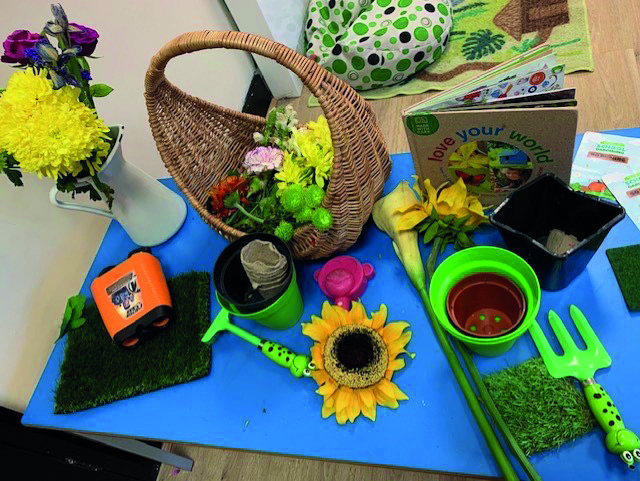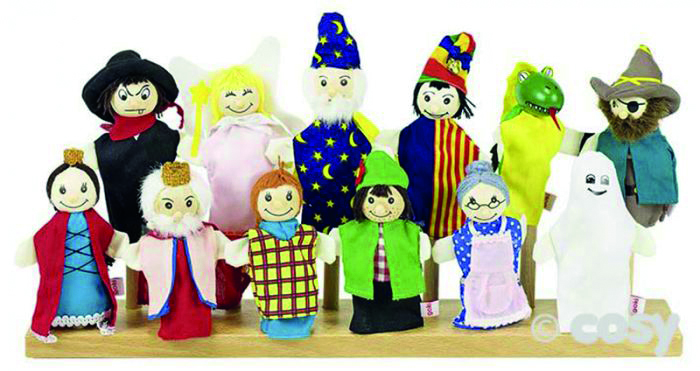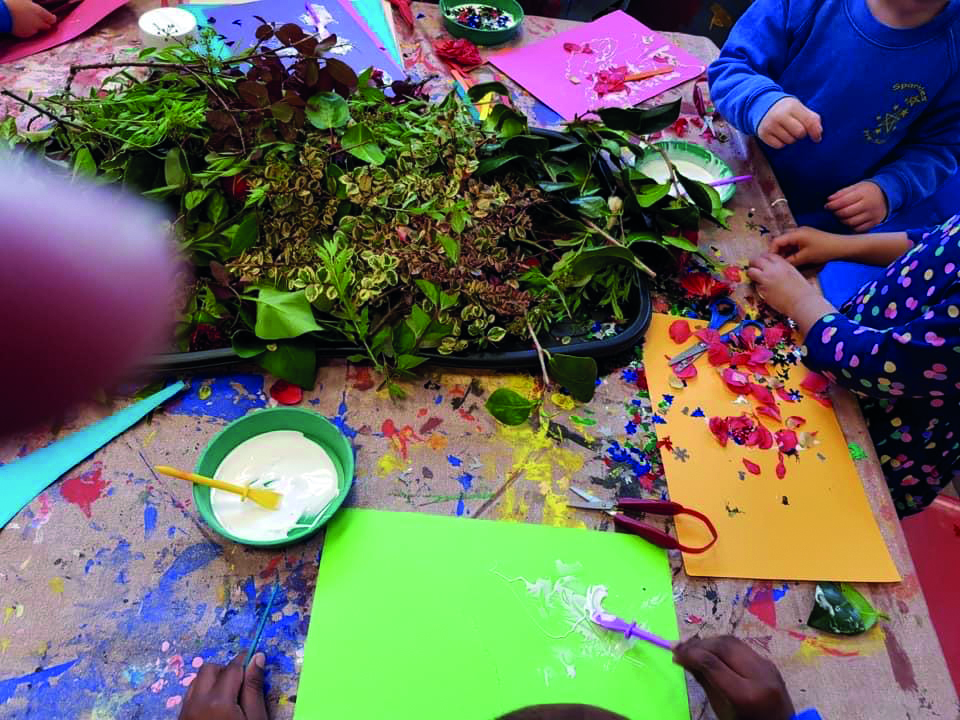
The arts provide children with a unique opportunity to discover and express their own voices through creative expression.
Early years and creative arts consultant Anni McTavish says language and communication can be significantly boosted by well-designed art activities in a setting. ‘Art is so open-ended, and if it is well facilitated and organised it can give children and adults lots of ways to share experiences and things they can’t say.’
Ms McTavish believes the key to encouraging and enabling children’s language development through arts is for adults to be ‘companions’.
‘It is about joining children on their artistic journey. If you are willing to stop and observe children, they can tell you a lot about themselves through the materials they choose and the ways they use them,’ she explains.
‘If you watch and wait rather than making assumptions, it could be that they are thinking about something quite different to what they are doing. It is helpful to make comments to show interest rather than immediately asking questions, and share the experience with them rather than sitting with a notebook and waiting for them to perform. Then you can enjoy the time together, too.’
WHAT TO OFFER

Ms McTavish recommends that all settings start by looking at their art provision.
‘Is there a healthy arts curriculum, not just mark-making and drawing, but also opportunities for messy and malleable play, clay, sculpture, music, movement, songs and rhymes, role play, small-world play, design and so on?’ she asks. ‘You don’t need lots of fancy-pants resources, but you need to know what you have and why.’
She adds that not all resources have to cost a fortune. ‘We may think we need lots of materials for art, but in fact different coloured leaves, fir cones and other natural resources, or recycled materials, can work just as well. We just have to think about how we support children to be creative with these resources, whether it is making patterns on the ground, transient art, or simply covering a cardboard box with different things.’
Language can then develop very quickly, as children learn terms for specific materials and techniques, from tearing and sticking to paint rollers and clay moulding, and begin to discuss why they have chosen one over another.
‘When children make something, they can feel so full of self-esteem and pride,’ Ms McTavish explains. ‘They learn that their opinion and the choices they have made are important and have value.’
WORKING TOGETHER
Other conversations can also spring forth as children work together to make art.
‘Art can be a good marker of when children are feeling safe enough in an environment to make and create together,’ says Ms McTavish.
‘Working with shared items can promote an encouraging atmosphere of goodwill. Children can learn how to ask for what they want in positive ways, and practise social skills like saying “thank you”.’
However, it is worth trying to ensure you have enough materials to go around so sharing doesn’t become a problem, she warns. ‘Turn-taking can be part of the conversation, but it is important that doesn’t become all of it.’
Creating art together can lead to the development of other skills, such as problem-solving and critical thinking. ‘You can encourage positive conversations, so rather than saying something is not good, children can be invited to give constructive feedback to themselves and each other. Help children to express their liking for someone else’s work, or work together to problem-solve and generate ideas to boost critical thinking.’

SMALL-WORLD AND ROLE PLAY
Small-world and role play can also help develop language, especially when based on books or stories children are already familiar with.
‘Art can be set up and guided by adults, such as small-world play scenes from a favourite book like The Kiss that Missed by David Melling, and then they can take note of where children go with it. Children will often develop imaginative stories even if they don’t have words yet.’
MUSIC AND MOVEMENT
As well as resources, finding space for dance, music and movement inside and outside is another important way to encourage communication through art.
After criticism of the ‘Performing’ Early Learning Goal (ELG) in the pilot revision of the EYFS, it has been renamed ‘Being Imaginative and Expressive’.
However, Ms McTavish points out that ‘an emphasis on performance can be reinterpreted in a positive way.
‘Children want to be seen, recognised and witnessed, and whether that is through music, drama, movement or visual art, it is very important.’
She suggests using art resources for music and movement, such as fabrics for dance or sponges dipped in paint thrown around outside on large pieces of paper.
‘I worked with a boy with cerebral palsy who benefited from a supportive chair, which gave him mobility but also acted as a barrier to his communication with others,’ she says. ‘He loved being on the floor with other children, and simple songs and games allowed him to do that. We were able to target movement sessions to support his physical development, and this deepened his connection with the group.’
SEND AND CREATIVITY
Ms McTavish adds that the arts have long been used to support mental health and express challenging feelings and emotions. ‘They are a very important part of a practitioner’s toolbox in supporting children with a host of different conditions,’ she says. ‘Selective mutes, for example, often benefit from the visual arts and role play, as it provides them with another way to communicate which can be less threatening.’
ART IN THE COMMUNITY
If practitioners do not feel confident in particular areas of art, looking outside the setting can provide further opportunities for communication.
‘Visiting artists can be very enlightening, and they often open up new conversations because they have a different way of thinking and engaging with children,’ says Ms McTavish. ‘A trip to a gallery or to see a local artist at work can help children make a connection to real art and the wider community. Watching a craftsperson at work can be a great experience, and gives children the chance to communicate with someone different, with specific skills, who is confident in the medium. This confidence will brush off on children and practitioners alike. There’s an awful lot of language in it, too.’
Above all, Ms McTavish says practitioners should not be afraid to get involved in any and all opportunities for art activities. ‘My priority would be to see practitioners doing more art and creative work. By joining children on their artistic journey, you get to know them, and they get to know you. This enjoyable time together will help you plan new and exciting art and design to develop learning further.’
RECOMMENDED RESOURCES

- A painting screen, like a sheet of Perspex on a stand, allows children to stand either side to do finger painting and have a conversation through the screen.
- A big roll of paper allows painting on the floor inside or outside. Think about scale, such as using small, large, shaving or decorating brushes and rollers, or use sponges covered in paint to throw around and encourage movement. Cosy has a range of brushes and mark-makers, https://www.cosydirect.com/brushes-and-mark-makers-15pk.html
- Basic clay tools such as rollers with patterns on can be supplemented with natural resources and rolling pins. Try TTS Giant Foam Pattern Rollers, https://bit.ly/2VrsCEY
- Powder paints teach colour mixing, rather than ready-mix paints. Try Reeves Powder Paint, https://amzn.to/2XGcLoM
- Baby finger paints, https://bit.ly/2VBg1PB
- A builder’s tray for colour mixing, so children can work in a group.
- A set of finger puppets, especially animals, which children feel very safe to project their own feelings and experiences onto. Check out Cosy’s, https://bit.ly/2RK7tVw
- Lengths of different coloured fabric and ribbon can be made into anything or used for movement and dance.
CASE STUDY: Kim Benham, senior manager of Sparkles and Millies Pre-schools in Croydon

‘Art should be child-led, and children will find creativity anywhere, so we have to think on our feet and respond to that. You know you’ve got a good activity when all the children have produced something different. If it all looks the same, you need to think again.
‘It’s about allowing children to move resources from one area to another and seeing where that goes. We have trolleys with trays of items like dry rice and pasta, paint, mirrors, sequins, gems or playdough, and the children mix them up and stick playdough on mirrors, or put paint on things. Managerially, all doing different things is my worst nightmare, but it’s really great for development! And the less you say “no”, the more you encourage creativity.
‘Transient art can be great, using man-made or natural resources. It can be cheap as chips and have the learning value of any craft you can think of. We use a lot of flowers in all sorts of ways; not just on the art table for cutting and sticking, but also floating in water, as dinosaur food, pulping into perfume or taking them apart. This encourages lots of language about colour, smell, texture and size.
‘We also like to use children’s interests in our art, so we recently made a ramp with paper and the children dipped toy cars in paint and drove them around. It was incredibly messy but tremendous fun, and created not only abstract, modern art, but also helped children talk about different speeds, how long track marks were, and mixing colours. It also encouraged team work, and we always use builder’s trays for making group pictures, so children have to work together to make it happen.
‘Of course you need dedicated art resources, like paints, glue and a big choice of paper, but you also have to think outside the box. Art projects are not necessarily planned. For example, we have tool benches in the home corner and one of our children, who doesn’t have much communication, suddenly started taking the legs off. We were going to stop him, but we realised he had a plan, and he explained he was going to build a ladder for a teddy. Slowly, other children came over to help him, and together we found a way to stop it sliding on the floor. There are often artistic moments like these that you don’t expect, and a practitioner who is on the ball will pick them out, go along with them, and let children fly.
‘Art can also help communication with families. Often, the “All About Me” form for new joiners gets put away after use, but our children decorate it to turn it into a “Family Book” showing who their family is and what they like to do at home. It’s a very nice all-round, ongoing project which unites art and PSED, and involves parents too.’
MORE INFORMATION
- Anni McTavish’s new book Expressive Arts and Design will be published by Routledge later this year, https://bit.ly/34EHbt2
- https://www.nurseryworld.co.uk/features/article/eyfs-activities-we-ve-explored-transient-art
- https://www.nurseryworld.co.uk/features/article/eyfs-best-practice-all-about-transient-art
- https://www.nurseryworld.co.uk/features/article/around-the-nursery-part-3-in-on-the-act
- https://www.nurseryworld.co.uk/features/article/around-the-nursery-part-6-a-rich-palette









